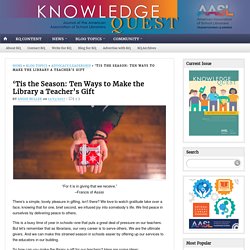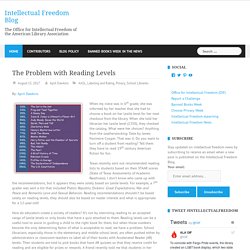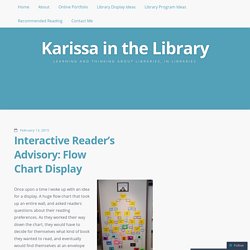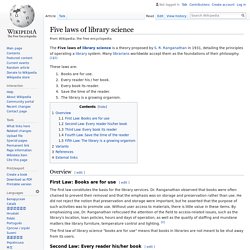

'Tis the Season: Ten Ways to Make the Library a Teacher's Gift. “For it is in giving that we receive.”

–Francis of Assisi There’s a simple, lovely pleasure in gifting, isn’t there? We love to watch gratitude take over a face, knowing that for one, brief second, we infused joy into somebody’s life. We find peace in ourselves by delivering peace to others. CO3 2010 Closer Look Report. AASL_infographic.pdf. Beating Heart of the School. Career trends. The Problem with Reading Levels - Intellectual Freedom Blog. By: April Dawkins When my niece was in 6th grade, she was informed by her teacher that she had to choose a book on her Lexile level for her next checkout from the library.

When she told her librarian her Lexile level (1350), they checked the catalog. What were her choices? Anything from the Leatherstocking Tales by James Fenimore Cooper. That was it. Texas recently sent out recommended reading lists to students based on their STAAR scores (State of Texas Assessments of Academic Readiness). How do educators create a society of readers? There are other reading programs out there, but Accelerated Reader is the most well-known one. And then there is the whole labeling and shelving issue. So, what do we do when the administration or teachers push to label books with Lexiles or AR levels? 12 (mostly cheap) Teacher Tricks that Work in an Elementary Library. Learning practical teaching tips and tricks is one of my favorite forms of professional development.

I love when others share simple things that can be applied quickly and easily to my teaching and improve learning for my students. Here are twelve tips and tricks that work in my library: A Magic Wand – This can truly be magic! This wand is used to dismiss students from the rug to move to other activities. It prevents the mob mentality that happens when everyone goes at the same time. A Mystery Box – Yes, this was once an ordinary tissue box, but now holds questions, vocabulary words, objects, or letters. Dewey Designs to Share — Katie Day.
But it was fairly monochrome and I envisaged associating different colors with different sections, much like the famous colored layout of rooms at Powells Books in Portland, Oregon (see colored section sign to the right).

So Maggie got permission from Susanna to modify her icons and to change the colors. Over the years people have asked Maggie for permission to use her designs -- and, so finally, in a creative commons way (in line with how Susanna allowed to build upon her original design), here they are -- click here to access a DROPBOX folder of all her files. A Snapshot of a 21st-Century Librarian. There’s a stereotypical image of a librarian in popular culture: someone older, in thick-rimmed glasses and overly modest clothing, guarding the silence in a room full of books with all-powerful shushes.

But as the internet has largely replaced brick-and-mortar libraries as the go-to resource for information gathering, librarians’ purview is no longer confined to just books. Libraries have had to evolve from providing the internet as a service, to being responsible for interacting with it, to indexing and archiving a rapidly increasing amount of information. Though the occupation is only expected to grow by 2 percent from 2014 to 2024, many librarians have forgone bookkeeping and cataloging for specializing in multimedia and taking on research- and technology-oriented projects such as digitizing archives. Theresa Quill, a research librarian at Indiana University, Bloomington, specializes in the relationship between geography and cultural behavior, and digital mapping. Interactive Reader’s Advisory: Flow Chart Display.
Once upon a time I woke up with an idea for a display.

A huge flow chart that took up an entire wall, and asked readers questions about their reading preferences. As they worked their way down the chart, they would have to decide for themselves what kind of book they wanted to read, and eventually would find themselves at an envelope with a booklist. This week I was able to make that display a reality at The Cambridge Idea Exchange! I love reader’s advisory tools that ask the users to make decisions for themselves about what they want to read.
Not only does it help them find a great new book, but it helps them figure out what they like, and why they like it. The Gift of Reading. The list of what a child needs in order to flourish is short but nonnegotiable.

Food. Shelter. Play. Love. Something else, too, and it’s meted out in even less equal measure. Words. Five laws of library science. The Five laws of library science is a theory proposed by S.

R. Ranganathan in 1931, detailing the principles of operating a library system. Many librarians worldwide accept them as the foundations of their philosophy.[1][2] These laws are: Books are for use.Every reader his / her book.Every book its reader.Save the time of the reader.The library is a growing organism. Overview[edit] First Law: Books are for use[edit] The first law constitutes the basis for the library services. Master of Management in Library and Information Science online.